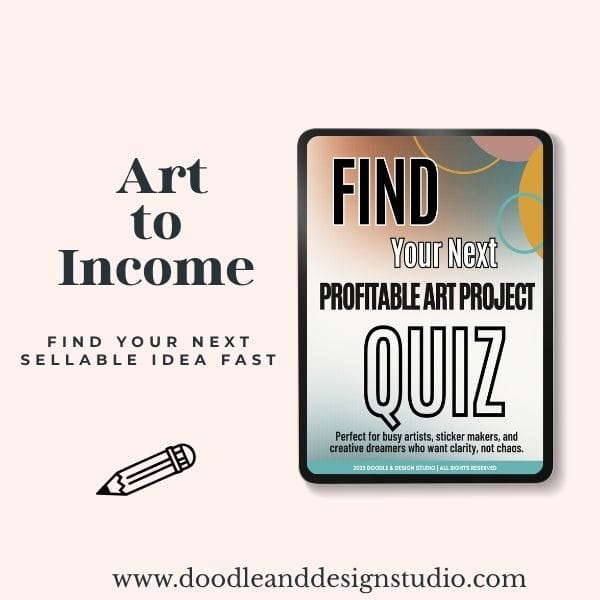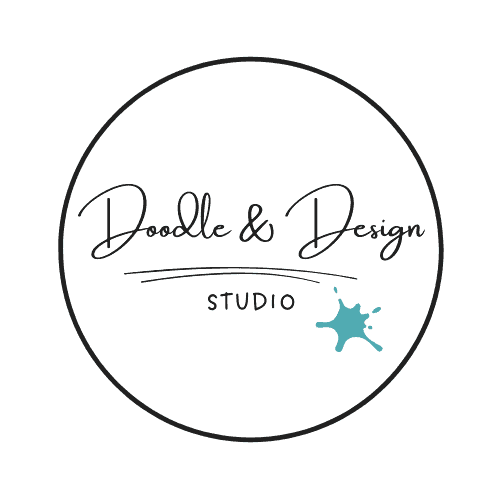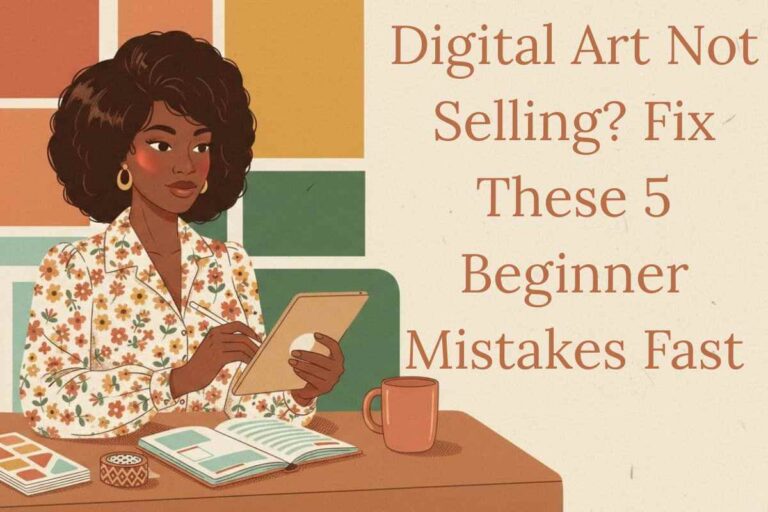3 Simple Steps to Turn Your Digital‑Art Ideas into Your First Sale (Without Losing Steam)

Wondering how to sell digital art but not sure where to begin?
You're not alone. You keep hearing people talk about selling digital art and opening an Etsy shop, or posting on Gumroad, and you're whispering, “That sounds like a great idea, I want to do that too!” Then your brain adds: “Cool… but where do I even start?”
Maybe you already uploaded a file to Etsy and got radio silence.
Here’s the path forward: three clear steps to go from idea to first sale, with bonus tips to help you avoid burnout.
Learn better by watching? Check out the short video for Beginner's Guide to Selling Digital Art
Short on Time?
Pick one product. Pick one platform. Stick with it until you sell. Don’t try to do everything at once.
Table of Contents
Step 1: Define Your Starting Point
What “Digital Art” Really Means
Digital art is a big umbrella, so let’s simplify with a few examples:
- Clip art
- Wall art
- Printable quotes
- Notebooks
- Stickers
- Bookmarks
- Seamless Patterns to put on products
Pick one — not all.
Why Picking One Product Matters
You don't need to figure out everything at once. Pick one, not two, not twelve. Think of it like choosing a lane before you hit the gas. It keeps you focused and cuts the chaos. Bold move, simple move, same move: pick one to keep focused.

Grab the quiz and find your next art-to-income idea.
I created this quiz to help busy creatives cut through the noise, find focus fast, and feel confident about what to make next.
Tools to Help Flesh Out Your Idea
- Free quiz if you can't decide a product: Cuts decision fatigue and gives you a quick win.
- GPT prompt for product ideas: Use AI to expand themes, styles, or layouts so you’re not staring at a blank canvas.
Action Steps:
- Take the quiz.
- Pick one product.
- Use the prompt to explore ideas.
If you want more idea fuel, check out these examples of Profitable Digital Products for Artists in this guide: 7 Digital Products Artists Can Sell That Actually Make Money.
Best Programs for Digital Art Beginners
You don’t need fancy or expensive software to start creating digital art. The goal right now is to pick one program that fits your style and feels easy to use not to master them all at once.
Beginner-Friendly Options:
- Canva – Best for printables, wall art, planners, and simple quote designs. Runs in your browser and includes tons of templates to get you started fast. It's ideal to create your own templates inside of Canva because anything ready made is going to come with licensing rules you need to follow, they are great to look at and get an idea for template layouts!
- Procreate – Perfect for iPad users who love to draw by hand. Great for illustrations, stickers, and clip art.
- Affinity Designer – A powerful, one-time-purchase alternative to Adobe Illustrator for vector-based designs.
- Krita – A free, open-source app made for painting and digital illustration on desktop.
If you’d like to strengthen your design eye, explore free lessons at the Canva Design School. It’s full of bite-sized tutorials on color, layout, and visual hierarchy — all the essentials that make your digital art look polished from day one.
Pro Tip: Don’t overthink your tools. Pick one, explore it for a few weeks, and focus on creating consistently — not switching programs every time you hit a snag.
Step 2: Pick Your Platform Wisely

Why focus on one platform
The plan is not to upload everywhere. Pick one platform, learn it inside and out, and stick with it while you build momentum. Less chaos = more results.
Popular Platforms to Consider
- Etsy (beginner-friendly)
- Gumroad (great for creators)
- Shopify (scalable)
- Squarespace (all-in-one)
- Your own website
Compare Without Overthinking
Give yourself a couple of hours to compare options, then make a choice. Do not hide in research mode for a week. You can pivot later. The magic is when you take action.
Step 3: Build Repeatable Habits for Success
Master One Product Workflow
Go from idea to live listing. Learn the process. When you know the process, you get faster.
That’s where speed and confidence come from. That is how you build a repeatable workflow without melting your brain.
Expect a Learning Curve
The first few rounds will feel slow. You will miss steps, forget sizes, and redo files.
That is fine. It is normal to feel overwhelmed, but repetition creates a rhythm.
Soon you are producing, batching, and tweaking your listings with calm confidence.
From clunky to smooth production
Here is the usual sequence:
- First attempt, clunky
- Several attempts = Repetition, rhythm gaining confidence
- 7 plus attempts = Batching like a boss, efficiently
The 1-Hour Digital Art Batching Routine

If you only have 60 minutes a day (or during nap time), this mom-friendly flow helps you create products without overwhelm.
Here’s how it breaks down:
- 10 minutes: Brainstorm one small idea — for example, a printable to help with “after-school chaos.”
- 20 minutes: Design a simple template in Canva or Procreate(or your program of choice)
- 15 minutes: Color and fine-tune
- 15 minutes: Export files, drop them into mockups
Repeat this rhythm weekly. Small steps win. The goal is to get to this point once you have mastered the process!
Traffic That Doesn’t Eat Your Entire Day

You don’t need to dance on TikTok 5x a day. Here's how to drive steady traffic with low-lift tasks:
- Pinterest: Post 1–2 pins per listing. Use vertical mockups. Add keywords to your pin title and description.
- Instagram Stories: Record a quick 10-second screen recording showing you filling in your planner or digital product.
- Email List: Offer a one-page printable (like a daily planner) in exchange for an email signup. Mention it in your listing and social posts.
Bonus Tip 1: Set Realistic Expectations
Most Sellers Don’t Succeed Overnight
YouTube loves income screenshots, but most sellers take time to build. It’s normal for small businesses to take months to gain traction. This is the long game.
How to Stay Motivated
Focus on wins: finishing a listing, improving a mockup, learning a new tool. It all adds up.
Tip: Track small wins weekly so you can see your progress.

Bonus Tip 2: Focus on Key Learning Areas
Core Skills to Improve Over Time
- Keyword research (use Etsy search bar or tools like Erank)
- Product listings (descriptions, pricing, SEO)
- Quality mockups (use Canva or Smartmockups)
- Workflow (batch tasks like designing, uploading, writing)
Be Consistent Before You Judge Results
Give yourself a real window to see results. Be consistent for at least a few months before judging your progress.
You need weeks — not hours — to build traction. Commit to posting and learning for at least 90 days.
Learning happens in layers. Don’t rush the climb.
have you joined the art to income:create & sale digital products facebook group?
If you’ve ever said, “I want to draw digitally, but I have no idea where to start,” this is your sign.
We learn Procreate tricks, share designs, celebrate tiny wins, and cheer each other on as we start selling what we make.
💕Join Us on Facebook✨

FAQs
How long does it take to make your first digital art sale?
Most creators take a few weeks to a few months to get their first sale, depending on niche, quality, and traffic.
Do I need to show my face or be on social media?
Nope. You can grow quietly with smart listings, keywords, and good mockups. Social helps, but isn’t required.
Is Etsy the best place to start?
For most beginners, yes. It’s easy to use and already has traffic.
Can I sell the same design on multiple platforms?
Yes, as long as the platform terms allow it. Keep your files organized to avoid mistakes.
If you want a behind the scenes look at moving from physical to digital, this story might help: Switching to Digital Products from Physical Crafts.

Get started today
- Take the free quiz – Find your product fit fast.
- Use the GPT prompt (it comes with the quiz) – Beat blank-canvas syndrome.
- Post your first listing – Done is better than perfect.
Key Takeaways
- Start small: one product, one platform, one goal.
- Action beats overthinking: research fast, then move.
- Learning curve is normal: every expert was once a beginner.
- Build for the long game: slow progress is still progress.
- You're allowed to try. You're allowed to grow.
You do not need perfection, you need motion. If you want more support, hang out with me on my YouTube channel, Doodle and Design Studio, for tutorials and pep talks.
Love and messy buns,
❤️
Cynthia McDonald
Helping women find creativity in the chaos — with stickers, stationery, and a little bit of fun
Make sure and grab your favorite Pinterest Pin and Save it to your Digital Art Pinterest Board











